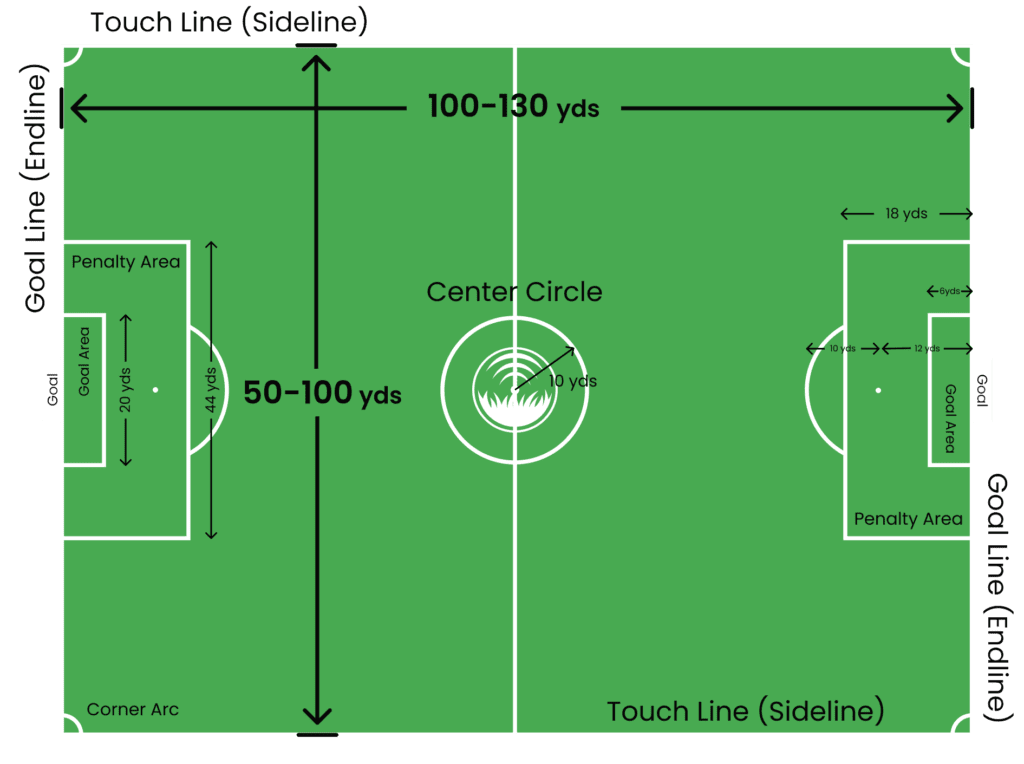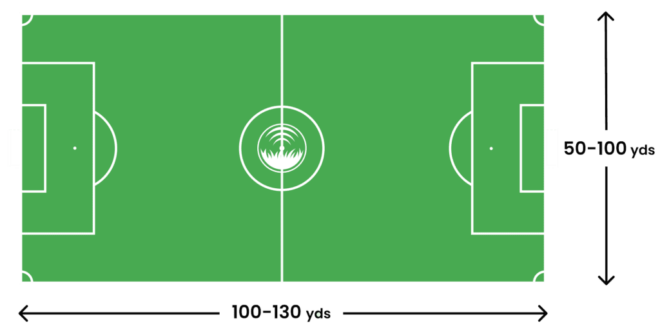A soccer field typically measures between 100 and 130 yards long and 50 to 100 yards wide. International matches require a field size of 110–120 yards long by 70–80 yards wide.
In exploring the world of soccer, one must consider the importance of the playing field. The dimensions of a soccer field, also known as a football pitch, can vary and are not fixed, allowing for flexibility based on age, league, and level of play.
The specified range adheres to the standards set by the sport’s governing body, FIFA, for matches at the professional level. The size becomes crucial when strategizing, as it affects players’ stamina and the game’s dynamics. Coaches and players must adapt their tactics to the size of the pitch, with larger fields favoring teams with greater physical endurance and speed. This adaptability makes soccer a diverse and globally appreciated sport, challenging athletes across varied playing surfaces.
🔴What is the Size of a Soccer Field🔴

Table of Contents
The Importance Of Field Dimensions In Soccer
The importance of field dimensions in soccer cannot be overstated. The field size affects players’ speed, strategies, and the game’s overall pace. Certain dimensions are ideal for fostering an exciting, flowing match that is enjoyable for players and fans alike. Different field sizes can lead to varied styles of play, influencing everything from the players’ fitness demands to the tactics a coach employs.
Impacts On Gameplay And Tactics
A vast field allows players more space to run and maneuver. This space benefits teams that rely on long passes and wide plays to penetrate opposition defenses. Conversely, a smaller pitch encourages quick passes and close ball control, necessitating a more tactical approach to break down the rival team’s players.
Changes in field size can affect players both physically and mentally. Larger fields require greater endurance and can tire out players quickly, while smaller fields demand high levels of concentration and technical skills.
Regulatory Standards For Official Matches
FIFA, soccer’s governing body, sets out clear guidelines for official match field dimensions. These standards aim to ensure a level playing field, enabling fairness and consistency across games worldwide. The recommended size for international matches is a length between 100 and 110 meters and a width between 64-75 meters.
| Field Component | Minimum Size | Maximum Size |
|---|---|---|
| Length | 100 meters | 110 meters |
| Width | 64 meters | 75 meters |
For non-international matches, fields may vary in size. The length can range from 90 to 120 Meters and the width from 45 to 90 meters. These flexible dimensions allow fields to accommodate various levels of play and spatial constraints. Still, they must adhere to the spirit of the game, which promotes fair and competitive matches.
Decoding Soccer Field Measurements
Imagine stepping onto a soccer field. You see green grass and white lines. But what do these lines mean? Let’s explore “Decoding Soccer Field Measurements. This will help us understand how big a soccer field is.
Length And Width Guidelines
Every soccer field has a rectangular shape. It’s important to note that the field’s size can change. The rules say fields should be between 100-130 yards long. They should also be between 50-100 yards wide. For international matches, the fields are a bit bigger. They should be between 110-120 yards long and 70-80 yards wide.
The guidelines ensure that the game is fair and exciting for everyone.
Variations Across Different Levels
Not all soccer fields are the same size. Youth soccer fields are smaller than professional ones. This is because younger players are smaller and have less stamina. Small fields make the game more fun for them. The size also changes based on the level of play, like school games or pro matches.
| Level | Length (yards) | Width (yards) |
|---|---|---|
| Youth | 70-80 | 40-50 |
| Amateur | 100-110 | 60-70 |
| Professional | 110-120 | 70-80 |
Remember, the size can change, but it is always within the guidelines. This keeps the game fair for players at every level.
International Standards For Field Size
When it comes to soccer, the size of the playing field can significantly influence the game.
The International Standards for Field Size ensure that professional matches offer a consistent playing experience worldwide.
These standards specify the minimum and maximum dimensions for pitch length and width, catering to the needs of professional play.
Fifa’s Criteria For Professional Play
The Fédération Internationale de Football Association (FIFA) sets rigorous standards for professional soccer fields.
According to FIFA, a professional soccer field must measure between 100 to 110 meters in length and 64 to 75 meters in width.
These dimensions are mandated for international matches, including the World Cup games.
Adaptations For Youth And Amateur Soccer
Recognizing that younger players and amateur leagues have different requirements, FIFA allows for adaptations in field sizes.
Youth soccer fields vary, depending on the age group. The sizes are generally smaller to accommodate their skill level and physicality.
Local leagues often use fields with dimensions that optimize available space while still fostering a quality soccer experience.
Here’s a quick reference:
| Age Group | Field Length | Field Width |
|---|---|---|
| U-6, U-7, U-8 | 25-35 meters | 20-25 meters |
| U-9, U-10 | 45-55 meters | 35-45 meters |
| U-11, U-12 | 70-80 meters | 45-55 meters |
Common Soccer Field Size Myths
Many fans and players hold false beliefs about soccer field dimensions. These myths can influence the game’s enjoyment and comprehension. Let’s debunk these myths and uncover the truth.
Professional Vs. Local Fields
Assumption: All professional fields are larger than local ones. This is not necessarily true. Professional soccer fields must adhere to FIFA standards, which dictate a length between 100-110 meters and a width of 64-75 meters. Local fields, though varied, sometimes match these dimensions or come close depending on available space and resources.
Misconceptions About Playing Area Sizes
Many believe standard field sizes exist. Here’s the reality:
- Fields don’t have one standard size. They vary within the FIFA guidelines.
- Smaller fields are not always easier to play on. Tighter space may increase ball control difficulty.
- Weather doesn’t dictate size. Fields retain their dimensions regardless of rain or shine.
Measurement Units In Soccer Fields
Understanding the size of a soccer field involves different measurement units. Soccer fields, also known as football pitches, vary in size. But their measurements share a common ground. Knowing both metric and imperial units is essential. It makes the game globally accessible and easy to follow.
Metric Versus Imperial Systems
The world speaks two main measurement languages. Soccer fields are no exception. The metric system uses meters and the imperial system uses feet and yards. These systems are different:
- Metric: Preferred worldwide
- Imperial: Used mainly in the United States
FIFA standardizes field dimensions using the metric system. They recommend a length of 100-110 meters and a width of 64-75 meters.
Conversion For Global Understanding
To appeal to fans and players globally, soccer field measurements have common conversions. Here they are:
| Metric Size | Imperial Equivalent |
|---|---|
| 100 meters | Approximately 109 yards |
| 110 meters | Approximately 120 yards |
| 64 meters | Approximately 70 yards |
| 75 meters | Approximately 82 yards |
These conversions help everyone visualize the field size. Soccer’s popularity grows with this global understanding.
Factors Influencing Field Size Variation
Please note that the HTML provided below is for illustration purposes and would require appropriate opening and closing tags for usage in a full HTML document.
The size of a soccer field can vary greatly from one pitch to another. This isn’t just random happenstance; several factors come into play that influence how big or small a field can be. Understanding these factors is crucial for players, coaches, and enthusiasts alike. Let’s dive into what causes these variations.
Club Preferences And Tactical Play
Different clubs have unique preferences that affect the size of their fields. These preferences often connect to the team’s playing style. Here’s what influences a club’s decision:
- Team’s Strategy: Bigger fields may benefit teams that excel in long passes and maintain possession.
- Player Attributes: Teams with faster players might enjoy larger spaces to exploit their speed.
Geographical And Climatic Considerations
Where a soccer field is located can lead to variations in its size. Here are the factors tied to geography and climate:
| Spatial Constraints | Climatic Impact |
|---|---|
| Urban Areas: Limited space could result in smaller fields. | Rainfall: Heavier rain areas might have smaller fields to reduce maintenance. |
| Rural Areas: Ample space may allow for larger fields. | Temperature: Extreme cold or heat could affect grass growth and field dimensions. |
Soccer Field Markings And Their Significance
The lines and markings on a soccer field are crucial. They define the play area and dictate rules. It’s vital for players and fans to understand what each marking means. This ensures a fair and enjoyable game. Let’s explore these markings and their significance.
Understanding The Lines And Boxes
The Field of Play is outlined with boundary lines. The long boundaries are the sidelines, while the short ones are goal lines. The field’s middle line splits it into two equal halves, each with a goal.
- The Center Circle: This circle has a 9.15 meters radius. It marks kick-off and maintains player distance during this time.
- The Touch Lines: These are the long lines on the sides. They show where the ball exits the field.
- The Goal Lines: Found at each end, they define where a goal may be scored from.
Corner Arcs: These small quarter-circles are at each corner. They indicate where corner kicks are taken.
Penalty And Goal Areas Explained
| Area | Size | Function |
|---|---|---|
| Penalty Area | 44 x 18 yards | Where goalkeepers can handle the ball and penalties are taken. |
| Goal Area | 20 x 6 yards | Area for goal kicks and where attacking free-kicks within this area are taken. |
The Penalty Spot is 12 yards from goal. It is the point from which penalties are taken.
Penalty Arc: A semi-circle outside the penalty area. It marks where players must stand during a penalty kick.
Each marking on a soccer field helps guide the flow of the game. These lines ensure the game is fair and structured. Defining areas for specific actions helps referees make accurate calls. Players can strategize around these areas to play effectively.

Maintenance Of Standard Soccer Field Sizes
Keeping a soccer field within regulation sizes is essential. It ensures fair play and consistency across matches. Simply put, the size of a soccer field can greatly affect the game. Groundskeepers face various challenges to maintain these standards. Advances in technology aid them. They help measure and maintain fields with great precision.
Challenges For Groundskeepers
Groundskeepers ensure fields are ready for match day. Each field must meet specific size requirements. The task is not always easy. Several factors create challenges:
- Weather conditions can damage the field
- Inconsistent growth of grass affects the surface
- Daily wear and tear from games and practices
- Need for precise line marking
Groundskeepers must work tirelessly. They combat these issues to uphold size regulations the sport demands.
Technological Advances In Field Measurement
Technology plays a pivotal role in maintaining field sizes. Groundskeepers now have tools for precise measurements and upkeep:
- Digital line marking systems ensure accurate boundaries
- GPS devices monitor grass growth and health
- Automated mowers provide consistent grass length
- Moisture sensors control the watering schedule
With these tools, groundskeepers can maintain fields. They keep them up to standard sizes. Moreover, they ensure optimal play conditions.

Frequently Asked Questions For What Is The Size Of A Soccer Field
What are standard soccer field dimensions?
The standard dimensions for a professional soccer field are 68-75 meters (70-80 yards) in width and 100-110 meters (110-120 yards) in length. FIFA’s Laws of the Game stipulate these sizes.
How does field size vary for youth soccer?
Youth soccer fields are smaller, ranging from 45-55 meters (50-60 yards) in width to 90-100 meters (100-110 yards) in length. Specific dimensions can vary based on the age group and league regulations.
Is there a minimum size for a soccer field?
Yes, the minimum size for a soccer field, according to FIFA, is 45 meters (50 yards) in width and 90 meters (100 yards) in length. These dimensions ensure a suitable playing surface for adult matches.
What factors influence the size of a soccer field?
Factors influencing soccer field size include the level of play, age of participants, and space availability. Regulatory bodies may also set specific guidelines for field dimensions.
Conclusion
Understanding the dimensions of a soccer field is crucial for players and fans alike. We’ve explored the varying sizes, acknowledging regulations set by FIFA. Embracing these measurements can enhance one’s appreciation of the game. Remember, whether it’s a local match or a professional battle, the field size sets the stage for all the action that unfolds.
 SMGB TODAY Sports, Movies, TV Shows
SMGB TODAY Sports, Movies, TV Shows

